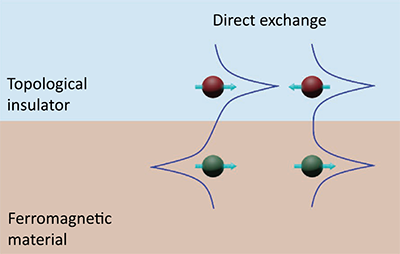| Aug 05, 2021 |
Mixing a cocktail of topology and magnetism for future electronics
(Nanowerk News) A new review article in Advanced Materials ("Recent Progress in Proximity Coupling of Magnetism to Topological Insulators") throws the spotlight on recent research in heterostructures of topological insulators and magnetic materials.
|
|
In such heterostructures, the interesting interplay of magnetism and topology can give rise to new phenomena such as quantum anomalous Hall insulators, axion insulators and skyrmions. All of these are promising building blocks for future low-power electronics.
|
 |
| Exchange effect: One of the pathways to magnetic ordering in topological insulators is a direct exchange at the boundary of the two materials. (© Wiley-VCH Verlag)
|
|
Provided suitable candidate materials are found, there is a possibility to realise these exotic states at room temperature and without any magnetic field, hence aiding FLEET’s search for future low-energy, beyond-CMOS electronics.
|
Finding the right mix of topology and magnetism
|
|
“Our aim was to investigate promising new methods of achieving the quantum Hall effect”, says the new study’s lead author, Dr Semonti Bhattacharyya at Monash University.
|
|
The quantum Hall effect (QHE) is a topological phenomenon that allows high-speed electrons to flow at a material’s edge, which is potentially useful for future low- energy electronics and spintronics.
|
|
“However, a severe bottleneck for this technology being useful is the fact that quantum Hall effect always requires high magnetic fields, which are not possible without either high energy use or cryogenic cooling.”
|
![topological insulator]() |
| When the two surfaces of topological insulators are magnetized parallel to each other, an energy gap opens on the surfaces to make them insulating, but the edges support resistanceless conducting states which can work like an electron highway. (© Wiley-VCH Verlag)
|
|
“There’s no point in developing ‘low energy’ electronics that consume more energy to make them work!” says Dr Bhattacharyya, who is a Research Fellow at FLEET, seeking new generation of low-energy electronics.
|
|
However, a ‘cocktail’ of topological physics and magnetism can make it possible to achieve a similar effect, the quantum anomalous Hall effect, where similar edge states appear without applying external magnetic field.
|
|
Several strategies have been followed to induce magnetism in topological insulators:
|
|
by incorporating magnetic impurity,
by using intrinsically magnetic topological insulators
by inducing magnetism through a proximity effect in topological insulator–magnetic insulator heterostructures.
|
|
“In our review, we focussed on the recent scientific research into heterostructures on the third approach,” says co-author Dr Golrokh Akhgar (FLEET/Monash). Ie, a single structure incorporating thin-film layers of topological insulators and magnetic materials adjacent to each other, allowing the topological insulator to borrow magnetic properties from its neighbour.
|
|
This approach allows researchers to tune each type of material, for example increasing the critical temperature for the magnetic material, and increasing the band gap, and decreasing the defect states, in topological materials.
|
|
“We think this approach for inducing magnetism in topological insulators is the most promising for future breakthroughs, because the magnetism and topology can be individually tuned in two different materials, thereby optimizing both to our advantage,” says co-author Matt Gebert (FLEET/Monash).
|
![Magnetic extension: The surface state of the topological insulator extends into the neighbouring ferromagnetic insulator]() |
| Magnetic extension: The surface state of the topological insulator extends into the neighbouring ferromagnetic insulator, interacting with magnetic moments via strong exchange interaction to produce a larger exchange bandgap and stronger insulating behaviour. (© Wiley-VCH Verlag)
|
|
Another important feature of this heterostructure is that the induced magnetism only depends on the magnetic moments of the nearest plane inside the magnetic material, hence the magnetic materials do not have to be ferromagnets—ferrimagnets, or antiferromagnets can also be used. This increases the number of candidate magnetic materials, allowing choice of materials with magnetism at higher temperatures, for operation closer to room temperature.
|
|
“This is an exciting new field of research,” says corresponding author Prof Michael Fuhrer, also at Monash University.
|
|
“Progress is happening extremely rapidly, and we felt it was time for a review article summarizing the recent accomplishments, and outlining a future roadmap of this field”, says Prof Fuhrer, who is director of FLEET.
|
The Study
|
|
This review provides all the information necessary to introduce new researchers to the field. It explains the conceptual ideas behind the mechanisms of magnetic proximity effect in topological insulators, introduces the materials systems that have been explored and the various emergent phenomenon that have been detected, and outlines a future roadmap towards increasing the temperature and innovative applications.
|
|
“We hope others will find it a timely review clarifying the important concepts of the field and recent publications,” says Semonti.
|



